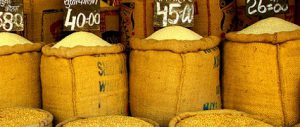The following extract, published with permission, is from the Worldwatch Institute’s State of the World 2011: Innovations That Nourish the Planet. The full report is available from Earthscan (non-US readers) and Worldwatch (US readers).
During the 1970s, rice paddies from India to Indonesia were threatened by grassy stunt virus. After a five-year search in which over 17,000 cultivated and wild rice samples were screened, a wild species Oryza nivara, growing near Gonda in Uttar Pradesh, was found that contained a single gene for resistance to a grassy stunt virus strain. Today, resistant rice hybrids containing the wild Indian gene are grown across some 110,000 square kilometres of Asian rice fields.
More recently, the cassava mosaic virus spread in Uganda in the 1990s, diminishing harvests by 70 to 100%. The brown streak virus then infected another 10% of the cassava crops in the region. Through three innovations, local research stations working with farmers developed improved disease-free cassava planting material and extended improved cultivation methods and post-harvest processing to large numbers of farmers.
These examples suggest one vital role of genetic diversity: maintaining a gene “tool kit” that can be tapped to counter various threats to crop production. Yet during the twentieth century, some 75% of the genetic diversity of agricultural crops was lost. Only about 150 plant species are now widely cultivated, of which just three supply almost 60% of calories derived from plants. The trend has been rapidly downward in many countries, and one result is dietary impoverishment. In four out of 10 countries recently surveyed, more than one third of children were stunted due to insufficient and poor-quality food, with deficiencies of key vitamins and minerals most common.
Worldwide, two billion people suffer from iron-deficiency anemia, including three quarters of pregnant women in south-west Asia, half in Africa, one third in the Americas, and one quarter in Europe. Anemia causes 65,000 maternal deaths per year in Asia, and severe vitamin A deficiency affects 100 million to 250 million children worldwide.
One key to reversing this trend is restoring biological diversity on farms. Rice paddies, for instance, were traditionally important sources of fish protein, and fish living in the paddies helped cycle nutrients and control pests. But many insecticides are toxic to fish, and their increased use since the 1960s eliminated beneficial fish from paddies. Pests and diseases thrive in monocultures because there is an abundance of food and few or no natural enemies to check their growth. In the end, pesticide resistance inevitably develops within populations and spreads rapidly unless farmers are able to use new products.
Take the insecticides away, though, and the fish can be reintroduced. This was done in China’s Jiangsu province; the result was rapid growth of rice aquaculture, from about 5,000 hectares in 1994 to 117,000 hectares in 2001 of rice/fish, rice/crab and rice/shrimp systems. Rice yields increased by 10 to 15%, but the greatest dividend was in protein: each mu (one fifteenth of a hectare) produced 50 kilogrammes of fish. Additional benefits included reduced insecticide use and measured reductions in malaria incidence owing to fish predation of mosquito larvae.
Biodiversity on farms often confers a range of benefits, including higher yields, lower odds of crop failure, and reduced weed risks, labour requirements and erosion. Some remarkable synergies can be obtained, as shown by the use of legumes and grasses to attract and repel parasites and pests. This “push-pull” system was recently applied to maize in Kenya with remarkable results. Researchers found that fodder and soil conservation grasses (such as Napier grass and molasses grass) attract stem borers [moths] to lay eggs on the grass rather than on maize, while legumes such as Desmodium act as repellents, driving the stem borers away. Desmodium is also a potent nitrogen-fixer and releases root allelochemicals that help control the parasitic weed Striga.
Napier grass also releases attractant chemicals at a high rate in the first hour of nightfall, just as the stem borer moths seek host plants for laying eggs; when the eggs hatch, 80% die, as the grass also produces a sticky sap that traps the larvae.
Introducing sustainable agriculture to very small landholdings has also returned promising results. Increasing on-farm diversity translates into increases in diversity of food consumed by households, including milk and animal products from dairy cows and fish protein from rice fields or fish ponds or from keeping poultry and pigs in home gardens. As production increases, so does domestic consumption, with direct benefit, in particular, for women and children’s health.
One approach has centred on the use of raised beds, which (after labor-intensive construction) result in better water-holding capacity and higher organic matter. These beds can be highly productive and diverse, as well as able to sustain vegetable growth during dry seasons when vegetables in markets are in short supply.
One FARM-Africa project in Kenya and Tanzania is focusing on the revival and extension of indigenous vegetables on small beds. With 500 small farmers organised into 20 groups, and on average 20 beds of amaranths, cowpeas, nightshades, spinach, kales or cabbage cultivated per farmer (on half to a whole hectare), farmers have been able to obtain greater returns from markets as well as use 50% less fertiliser and 30% less pesticide than with conventional vegetables. Individual growers can harvest five to eight crops of amaranth and nightshade per year, generating an annual income of some US$3,000 to $4,500.
Rural people who integrate on-farm diversity and ecologically sound practices are eating more food and a greater diversity of it, which has a fundamental impact on health. This in turn allows adults to be more productive and children to attend school and concentrate on learning. Sustainable agricultural systems thus tend to have a positive effect on natural, social and human capital, while unsustainable ones feed back to deplete these assets for future generations.
Vanessa Arcara of Slow Food USA adapted this article from work by professor Jules Pretty of Britain’s University of Essex.
This extract, published with permission, is from the Worldwatch Institute’s State of the World 2011: Innovations That Nourish the Planet. The full report is available from Earthscan (non-US readers) and Worldwatch (US readers). State of the World 2011: Innovations That Nourish the Planet © Copyright 2011, Worldwatch Institute
Homepage image frim Lollie-Pop


